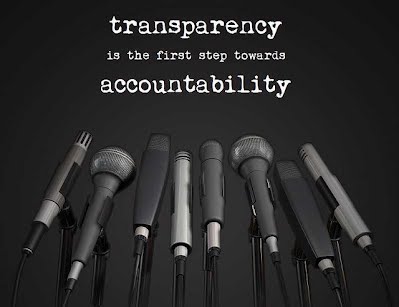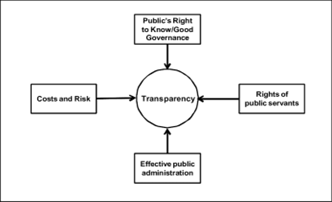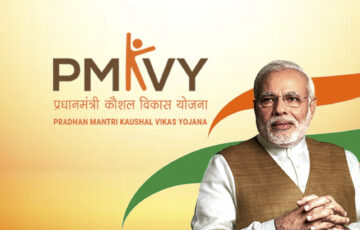Transparency And Accountability 1.0
Relevance
- GS Paper 2 Important Aspects of Governance, Transparency and Accountability, E-governance- applications, models, successes, limitations, and potential; Citizens Charters, Transparency & Accountability and institutional and other measures.
- Tags: #Governance #GS2 #TransparencyAndAccountability #UPSC #CitizenCharter #InitiativesForTransparency #InitiativesForAccountability.
What is Transparency And Accountability?
Transparency, in the context of governance, refers to the practice of making information, processes, and decisions of public institutions and officials readily accessible, visible, and understandable to the public. It involves openness, clarity, and the absence of hidden agendas.
What is the need?
Allows citizens to scrutinize government’s actions, promote accountability, and foster trust in public administration.
Accountability, in the context of governance, refers to the obligation and responsibility of individuals, organizations, or institutions to answer for their actions, decisions, and policies. It entails the willingness and ability to provide an accurate account of one’s activities, accept consequences for any shortcomings or failures, and demonstrate transparency in the use of resources and exercise of power.
What is the need?
Accountability is a fundamental principle in ensuring that public officials and institutions remain answerable to the citizens they serve, thereby upholding the rule of law and promoting good governance.
Stakeholders of Transparency And Accountability
These stakeholders play a critical role in advocating for and ensuring transparency and accountability.
- Citizens
- Government officials
- Media
- Civil Society Organizations
- International entities
- Whistleblowers
- The judiciary
- Transparency-focused Organizations
- Ombudsman offices
- Political parties
Role/ Importance Of Transparency And Accountability
Transparency and accountability are fundamental pillars of good governance, and their importance cannot be overstated.
- Trust Building: Citizens who have access to information are more likely to trust those Government’s actions .
- Effective Decision-Making: Provides decision-makers with accurate, up-to-date information enabling them to make informed choices.
- Preventing Corruption: When government actions are open to scrutiny, corrupt practices become more difficult to hide.
- Citizen Engagement: Informed Citizens can engage in discussions, advocate for their interests, and hold officials accountable.
- Resource Allocation: Ensures that public resources are allocated fairly and efficiently.
- Rule of Law: Upholds the rule of law by ensuring that government actions adhere to established laws and regulations.
- Social Inclusion: Transparent governance considers the needs and interests of all segments of society, including marginalized and vulnerable groups.
- Public Service Delivery: Ensures that government agencies provide essential services effectively and responsively.
- International Standing: Nations with transparent and accountable governance systems have better international reputations and are more attractive to foreign investment and partnerships.
- Long-Term Sustainability: It builds confidence among citizens and investors, promoting economic growth and development.
Initiatives to Enhance Transparency In India
1. Citizen’s Charter
- Adopted In 1997 , Citizen’s Charter is a written document that outlines the commitments and standards of public services provided by government departments and agencies to citizens.
- Aims to ensure transparency and accountability in public administration by specifying service delivery timelines, procedures, and the rights and responsibilities of both citizens and government officials.
- The Citizen’s Charter empowers citizens to hold government entities accountable for efficient and quality service delivery.
2. Right to Information (RTI) Act
- The Right to Information (RTI) Act in India, enacted in 2005, grants citizens the legal right to access information held by government authorities and agencies.
- Under this act, any citizen can request information about government decisions, actions, and policies, promoting transparency and accountability.
- Public officials are required to respond within a specified timeframe.
- The RTI Act empowers citizens to seek information and serves as a crucial tool in combating corruption, enhancing government accountability, and ensuring the public’s right to know.
3. E-Procurement
- E-Procurement refers to the use of digital technology and online platforms for conducting procurement processes. It streamlines and automates procurement activities, including sourcing, bidding, vendor selection, and purchase order generation.
- E-Procurement enhances transparency and accountability through
- centralized records
- real-time tracking
- digital audit trails
- competitive bidding
- accessible information
- reduced manual intervention
- standardized processes
4. E-Governance
E-Governance or electronic governance, is the use of information and communication technology (ICT) to streamline and improve the efficiency, accessibility, and transparency of government operations and public services
It enhances accountability and transparency by
- Digital Records: Reduces the risk of data manipulation.
- Real-time Monitoring: deterring deviations from established procedures .
- Accessible Information: Citizens can access government information and services online, promoting transparency.
- Data Analytics: To identify irregularities and inefficiencies, increasing accountability.
- Online Transactions: reduce opportunities for corruption and enable better tracking of financial flows.
5. Right to Public Services legislation
- Right to Public Services (RTPS) legislation is a legal framework that guarantees citizens timely and efficient access to essential public services.
- These laws require government agencies to deliver specific services within prescribed timeframes, ensuring accountability and transparency in service delivery.
- RTPS legislation empowers citizens to demand services without unnecessary delays, reducing bureaucracy and corruption.
- It promotes good governance and accountability by holding public officials responsible for providing essential services promptly and efficiently.
Initiatives To Enhance Accountability In India
Public Accounts Committee
- The Public Accounts Committee (PAC) in India is a vital parliamentary committee consisting of Members of Parliament (MPs) responsible for scrutinizing government expenditures and financial transactions.
- The PAC reviews the CAG’s reports, which highlight financial irregularities and inefficiencies in government spending.
- The PAC ensures accountability by examining these reports, questioning government officials, and recommending corrective actions.
- It plays a crucial role in overseeing and upholding financial transparency.
Comptroller and Auditor General (CAG)
- The Comptroller and Auditor General (CAG) in India under Article 148 is a constitutional authority responsible for auditing government finances and expenditures.
- CAG conducts financial and performance audits of government departments and agencies. Through these audits, CAG identifies financial irregularities, assesses the efficiency of government programs, and recommends improvements.
- By scrutinizing public spending, CAG helps prevent mismanagement, promotes responsible resource allocation, and strengthens the financial integrity of the government.
Public Accounts Committee(PAC)
- PAC in India is a crucial parliamentary committee composed of Members of Parliament (MPs). Chaired by an opposition member, it examines the government’s financial transactions and expenditures.
- PAC reviews reports by CAG to ensure transparency and accountability in government spending.
- By scrutinizing CAG’s findings, questioning officials, and making recommendations, PAC plays a vital role in holding the government accountable for its financial management, fostering transparency, and reinforcing responsible financial practices in India’s public administration.
Central Vigilance Commission (CVC)
- The Central Vigilance Commission (CVC) in India is an autonomous anti-corruption agency.
- It oversees government officials’ conduct, investigates corruption cases, and promotes transparency and integrity in public administration.
- The CVC acts as a watchdog, ensuring accountability and preventing corruption within government agencies. It plays a crucial role in maintaining ethical standards and good governance in the public sector.
Lokpal and Lokayukta
- The Lokpal and Lokayukta are ombudsman institutions in India tasked with addressing corruption and grievances against public officials.
- Derives Power from The Lokpal and Lokayuktas Act, 2013 The Lokpal, at the national level, investigates complaints against high-ranking government officials, including the Prime Minister.
- Whereas Lokayukta serves a similar role at the state level. They provide an avenue for citizens to report corruption, promote transparency, and ensure accountability within the government.
Centralized Public Grievance Redress and Monitoring System (CPGRAMS)
- CPGRAMS is an online platform in India for citizens to register and track complaints and grievances related to government services.
- It centralizes the grievance redress process, making it easier for citizens to voice concerns and receive timely responses from government departments.
- CPGRAMS enhances transparency, accountability, and efficiency in addressing public grievances, promoting good governance.
Public Interest Litigation
- Public Interest Litigation (PIL) under Article 32 is a legal mechanism in India that allows individuals or organizations to file lawsuits on behalf of the public or a marginalized group when there is a perceived violation of constitutional or legal rights.
- PIL serves as a tool for social justice, addressing issues such as environmental protection, human rights, and corruption.
- It empowers citizens to seek court intervention in matters of public concern, promoting accountability and access to justice while safeguarding the common good.
In conclusion, transparency and accountability are the cornerstones of effective governance. They empower citizens, deter corruption, and foster trust. Embracing these principles is not just a choice; it’s a necessity for a just and prosperous society.
| Mains Question
In the context of contemporary governance challenges, elaborate on the vital roles played by diverse stakeholders in ensuring good governance. Illustrate initiatives aimed at promoting and enhancing the principles of good governance. |









